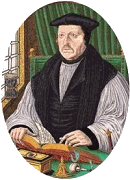| Filling a Need | |||||||||
|
In the early 1560's the Church of England had a dilemma on its
hands. Many of its paritioners, anxious to read the Scriptures for themselves in English, had
purchased a copy of the
Geneva Translation of the Bible. The Geneva Translation was the best English version of the Bible up to
that time -- and the Church of England knew it. They had little problem with its text; but they did object to the Notes that were
printed in the margins. Most of these Notes were written by English Protestants who had to flee England
to escape the persecution of the Church. Some of these Protestant-oriented notes were
highly critical of both the Church of England and the Roman Catholic Church.
In addition, the Geneva Translation was showing up many of the weaknesses of the Great Bible. This was a problem for the Church because at the time the Great Bible was the official Bible of the Church of England. The solution seemed obvious — time for another English Version of the Bible — 'we'll improve on the Great Bible and we won't use all those offensive Notes that are in the Geneva Translation.' | |||||||||
| Several Scholars — One Bible | |||||||||
 Matthew Parker Editor-in-Chief Bishops' Bible Parker reviewed the individual works, made his own corrections and changes, and compiled the whole thing into a complete Bible. When it was published in 1568, it was called the Bishops' Bible because it was the work of so many bishops of the Church. Upon its release, a sumptuous, beautifully-bound copy of the Bishops' Bible was presented to Queen Elizabeth. Great effort was spent in making the Bishops' Bible attractive by the addition of woodcuts and 123 engravings of maps, coats-of-arms, and portraits — even Queen Elizabeth found herself pictured on the Title Page. The paper used was of superb quality and the printing met the highest standards of the day. The Bishops' Bible was the most beautiful Bible to that time. But would it be able to upstage the Geneva Translation? | |||||||||
| Good Version, but not Really an Improvement | |||||||||
|
As soon as it was released, the Bishops' Bible became
the official Bible of the Church of England, and began replacing copies of the Great Bible in churches.
In 1571 it was decreed that "every archbishop and bishop should have at his house a copy of
the holy Bible of the largest volume as lately printed in London. ...and that it should be placed
in the hall of the large dining room, that it might be useful to their servants or to strangers."
However, neither decrees, nor fancy printing, nor pretty pictures did any good toward making the Bishops' Bible upstage the Geneva translation. Both its large physical size and the quality of some of its translations worked against its popularity. As an example of change just for the sake of change, the phrase "Peter's mother-in-law" as found in the Geneva Bible was changed to "Peter's wives mother". Now this may seem like a small thing, and it may be a more accurate translation from the original language, but it certainly did nothing enhance the Bible's readability.
The Bishops' Bible never measured up to the standard and quality of the Geneva Translation. It would take the next major English Version -- the King James Version -- to finally unseat the Geneva translation's reputation for being the English Bible. | |||||||||